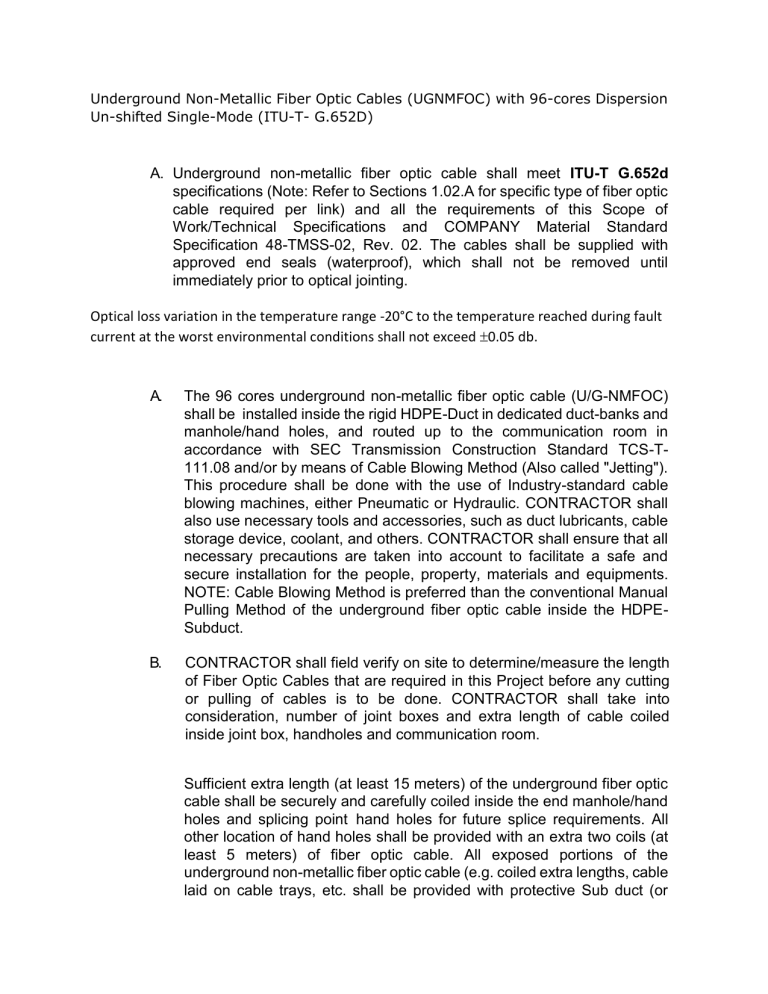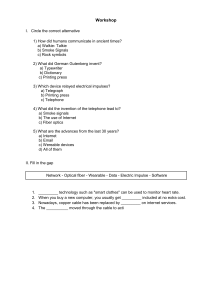
Underground Non-Metallic Fiber Optic Cables (UGNMFOC) with 96-cores Dispersion Un-shifted Single-Mode (ITU-T- G.652D) A. Underground non-metallic fiber optic cable shall meet ITU-T G.652d specifications (Note: Refer to Sections 1.02.A for specific type of fiber optic cable required per link) and all the requirements of this Scope of Work/Technical Specifications and COMPANY Material Standard Specification 48-TMSS-02, Rev. 02. The cables shall be supplied with approved end seals (waterproof), which shall not be removed until immediately prior to optical jointing. Optical loss variation in the temperature range -20°C to the temperature reached during fault current at the worst environmental conditions shall not exceed 0.05 db. A. The 96 cores underground non-metallic fiber optic cable (U/G-NMFOC) shall be installed inside the rigid HDPE-Duct in dedicated duct-banks and manhole/hand holes, and routed up to the communication room in accordance with SEC Transmission Construction Standard TCS-T111.08 and/or by means of Cable Blowing Method (Also called "Jetting"). This procedure shall be done with the use of Industry-standard cable blowing machines, either Pneumatic or Hydraulic. CONTRACTOR shall also use necessary tools and accessories, such as duct lubricants, cable storage device, coolant, and others. CONTRACTOR shall ensure that all necessary precautions are taken into account to facilitate a safe and secure installation for the people, property, materials and equipments. NOTE: Cable Blowing Method is preferred than the conventional Manual Pulling Method of the underground fiber optic cable inside the HDPESubduct. B. CONTRACTOR shall field verify on site to determine/measure the length of Fiber Optic Cables that are required in this Project before any cutting or pulling of cables is to be done. CONTRACTOR shall take into consideration, number of joint boxes and extra length of cable coiled inside joint box, handholes and communication room. Sufficient extra length (at least 15 meters) of the underground fiber optic cable shall be securely and carefully coiled inside the end manhole/hand holes and splicing point hand holes for future splice requirements. All other location of hand holes shall be provided with an extra two coils (at least 5 meters) of fiber optic cable. All exposed portions of the underground non-metallic fiber optic cable (e.g. coiled extra lengths, cable laid on cable trays, etc. shall be provided with protective Sub duct (or COMPANY approved equivalent) on manhole/hand hole and inside the building shall be corrugated, flexible with 25 mm outside diameter. Protective Sub duct inside the building shall be fire/flame retardant (2 hours UL fire rating). Protective Sub-ducts installation shall be in accordance with SEC Transmission Construction Standard TCS-T111.08. Nylon pull ropes 1/4-inch diameter (of different colors) shall be provided and installed in all vacant duct/sub-ducts. D. All other locations of communication manholes/hand holes along the routing path shall be provided with a minimum two (2) coils (5 meters) of Fiber Optic cable to allow for manhole/hand-hole distribution and future cable cuts. D. All necessary and required communication conduits, sub ducts, cable trays, raceways and ladders shall be provided by the CONTRACTOR to completely route the optical fiber and other communication cables from their designated ends up to the communication equipment locations. E. Splicing requirements, At all Fiber Optic’s splice locations where CONTRACTOR shall be required by SEC to splice Underground to Underground Fiber Optics cable in accordance with SEC Transmission Construction Standard TCST-111.06. The average loss per splice shall be 0.05 dB maximum (measured in both direction), the Optical Fiber splice loss measured in each direction using an OTDR shall be 0.15 dB maximum. F. Fiber Optic Splicing shall be done by experienced Fiber Optic cable splicer’s (COMPANY approved/certified) using an Automatic Fusion Optical Fiber Splicing Machine with built-in estimated Optical Fiber Splice Loss Reading capability. The estimated splice loss shall be less than 0.05 dB. G. Fiber Optic Testing shall be done by experienced Fiber Optic cable tester (COMPANY approved/certified) using state of the art, precise and calibrated fiber optic cable test equipments.



